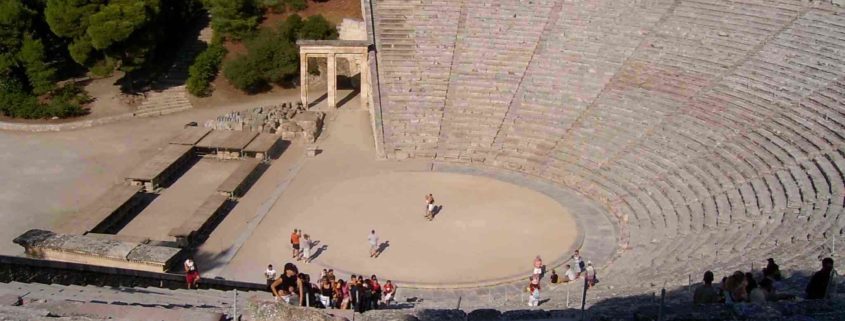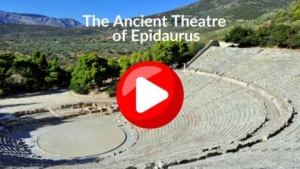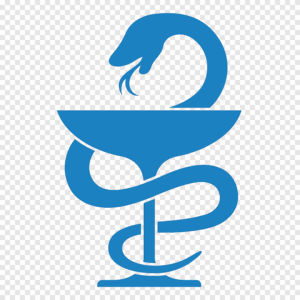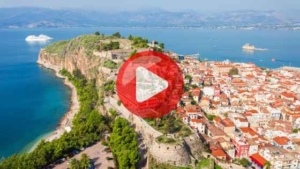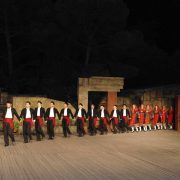When visiting Greece, it is not just about eating delicious food in taverns and going to the beach, but many travelers, including Omilo students,
also love to visit ancient Greek sites, attend Greek concerts, or theatre productions, while learning more about Greek culture and history.
Well, here is the good news, by visiting the beautiful archaeological site of Epidaurus, as well as the village « Palaia Epidaurus », you can combine it all!
Epidaurus
Nowadays, two modern towns have the name Epidavros:
The Old Epidaurus – παλαιά Επίδαυρος and
the New Epidaurus – Νέα Επίδαυρος.
If you visit the region for the first time, it can be a bit confusing, so let’s start with some explanations and geography!
New Epidaurus – Νέα Επίδαυρος.
This is a village, in the east of Argolis peninsula, 40 km east of Nafplion.
Until 1928 it was called Piada. The residents are mainly farmers and fishermen.
During the summer months, they are involved in tourism like running hotels, restaurants and bars.
The settlement is built in the interior part of a steep rock only few kilometres from the sea.
Old Epidaurus – παλαιά Επίδαυρος
Epidaurus was a small city in Ancient Greece, and now it is a village.
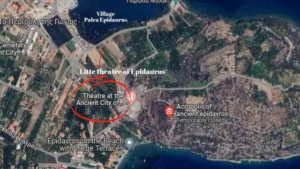
The Little Theatre of Ancient Epidaurus
Old Epidaurus has a « little theatre », in the heart of the village, near the port of Palea Epidaurus.
Although it is older than the well-known great theater of Asklepiion of Epidaurus (at 8km – for info, see below), its presence remained in obscurity until the 70s.
Then it was discovered, under a field of olive trees and its restoration process continues till today.
Its construction started in the 4th century B.C. and was originally built to cover the needs of this small city-state, so its size was not big.
It had 9 tiers and 18 rows of seats and could host about 2,000 spectators. Some seats have inscriptions which show that the theatre was dedicated to the God
Dionysus, the ancient Greek god of theater, wine ..
Its position is excellent, in an atmospheric setting, with views reaching to the sea from the upper stands.
It was rebuilt in the Roman era and continued to function for 700 years, until it was lost under tons of soil and forgotten.
The Epidaurus Little Theatre hosts today the annual Greek Festival, celebrated in summer with music, dance and theatre performances.
There are seats for 800 spectators and work is done to restore more of them. The performances are mostly held in modern or ancient Greek.
Getting there;
The Little Theatre of Epidaurus is located in the Argolis prefecture of the Peloponnese. It is a 45-minutes drive from Nafplio and approximately two hours from Athens.
Entry to the Little Theatre is via Palea Epidaurus. You can also go by KTEL bus from Athens to Old Epidaurus, and then walk another 15 minutes.
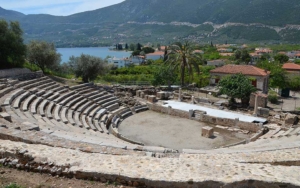
It is also close to the beach, so it can be combined with swimming and a tavern meal next to the sea!
Here below you get a better idea of where everything is located.
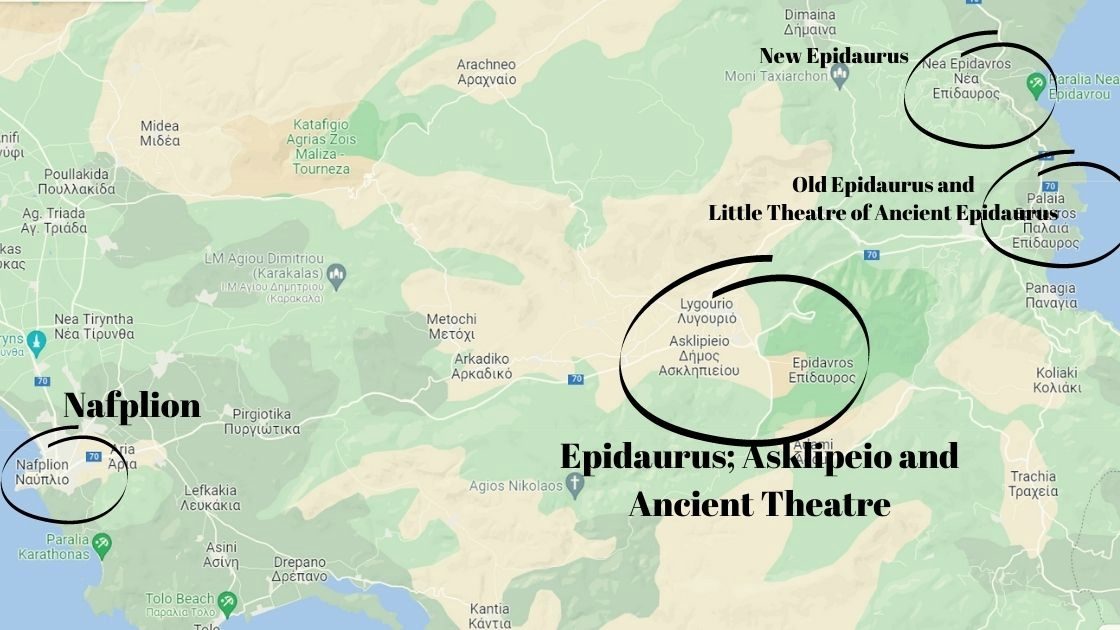
Epidaurus and its Ancient Theatre.
Epidaurus was the main sanctuary of Asklepios in Greece (read more info below).
The Ancient Theatre of Epidaurus is located within the archaeological site of the Sanctuary of Asklepios.
It is a half-hour drive from Nafplion and approximately two hours from Athens. The Ancient Theatre of Epidaurus is again in use, and the most popular tourist attraction in the area.
The impressive amphitheater was built in the 4th century BC, lying, as do most Greek theatres, against a slope.This theatre is by far the best-preserved theatre in Greece and has magnificent acoustics. The first row was reserved for dignitaries; their seats have backs, making them into regular chairs. The complex had two entrances; the western has been restored to give an impression of the original theatre. The skènè (stage) in its oldest phase had been a simple tent, but was later made of wood.
Nowadays, during performances, a new stage building is erected on the site.
Take a look at our video below.
The magnificently built venue is dedicated to ancient Greek drama, hosting tragedies and comedies performed by Greek and international theatre groups alike, with English subtitles for international visitors. Capacity: 14,000
The theatre also hosts part of the important “Athens and Epidaurus festival”,
which is usually staged in the summer, bringing ancient and modern plays, musical performances etc.
Read here for more information about this festival.
Who is Asclepius (or Asklepios)?
Epidaurus was the main sanctuary of Asklepios in Greece, originally a “sacred forest”, an enclosed territory dedicated to Asklepios.
Asklepios is the Greek god of healing. In mythology, he was the son of Apollo and the Thessalian princess Koronis, who died at childbirth. Asklepios himself was rescued and suckled by a goat. He was brought up by the centaur Cheiron, who instructed him in the art of healing, becoming so successful, that he even cured death. Of course, the god of death complained and Asklepios was killed by a thunderbolt hurled by Zeus, the king of the gods.
His cult was immensely popular in the 4th century B.C. From all over the Hellenistic and Roman world the suffering came to his sanctuary for a cure. After the perquisite rites, they would go to sleep in the « enkoimeterion » close to the temple, in the hope that they would be visited by the god himself who would show them a cure or perform an operation himself. (As you might know, κοιμάμαι means ‘to sleep’, so a κοιμητήριον is ‘a place to sleep’, although most suffering would gladly escape the English derivative, a ‘Cemetery’).
All the buildings around the temple were erected for these pilgrims and many votive gifts testify to the gratitude of the cured.
From Epidaurus, the cult of Asklepios spread over the ancient World. In his sanctuary at the Greek island of Kos, medicine developed into a science. Later his cult was also brought to Rome where Asklepios is named as Aesculapius.
His staff with holy snakes has become a symbol of medicine.
The Greeks regarded snakes as sacred and used them in healing rituals to honor Asclepius, as snake venom was thought to be remedial and their skin-shedding was viewed as a symbol of rebirth and renewal.
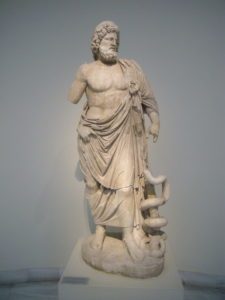
Nowadays, pharmacies around the world, still use the
« snake-sign »
Epidaurus Museum
The museum next to the theatre houses numerous objects from the sanctuary, like a collection of medical instruments made of bronze and inscriptions referring to numerous diseases (tapeworm, eye-, kidney and bladder diseases), images of Asklepios and his daughter Hygeia and large parts of the sculptures of the temple of Asklepios.
++++++++++++++++++++++++
Plan your trip and visit
In case you did not visit the Epidaurus or the broader area yet, we suggest to add it to your “to-do list”!
You could start by visiting the beautiful seaside town of Nafplion, a two-hour’ drive from Athens or easily accessible by public bus from Athens.
Accommodation in Nafplion
When visiting Epidaurus, it is a good idea to also visit Nafplion, and book your accommodation in this nice seaside town.
More info about accommodation, at https://omilo.com/accommodation-in-nafplion/
From Nafplion you need a 30-45 minutes drive till Epidaurus (you can also take a taxi from Nafplion).
More interesting places and archeology in the Peloponnese
While Epidaurus is world-renowned for its impressive ancient theater and healing sanctuary, the Peloponnese is also home to many other fascinating archaeological sites worth exploring. Just a short drive away, you can visit the ancient city of Mycenae, once the powerful center of the Mycenaean civilization and famous for its Lion Gate and royal tombs. Nearby, Tiryns impresses with its massive Cyclopean walls, showcasing the engineering skills of the same era. Further south, Ancient Messene offers a remarkably well-preserved city layout, with a theater, stadium, and public buildings nestled in a peaceful valley.
Also, do not forget to visit Nemea, another beautiful archeological site, temple and ancient stadium, off the beaten track! Click here to read more
Whether you’re a history enthusiast or simply curious about Greece’s rich past, these sites offer a deeper glimpse into the region’s cultural heritage beyond Epidaurus.
 eBOOK BEYOND ATHENS
eBOOK BEYOND ATHENS
If you are interested in Mycenae and other interesting sites you can visit as a day trip from Athens, then this eBook will be very useful for you.
Click here to learn more
eBOOK 7 GREEK ARCHEOLOGICAL SITES
Are you interested in Greek Archaeological Sites, as well as UNESCO sites, all over Greece, as well as 2 sites in the Peloponnese (Mycenae and Mystras) Then this eBook is ideal for you.
Learning Greek in Nafplion
Are you in love with Greece, visit Greece regularly, and interested to also start learning Greek?
Then it is good to know that Omilo organizes every year during the Easter Holidays, a Greek Language and Culture course in Nafplion
(and on other locations such as Athens, Lefkada, Syros and Naxos)
Click here to watch a small video, so you get a better idea

